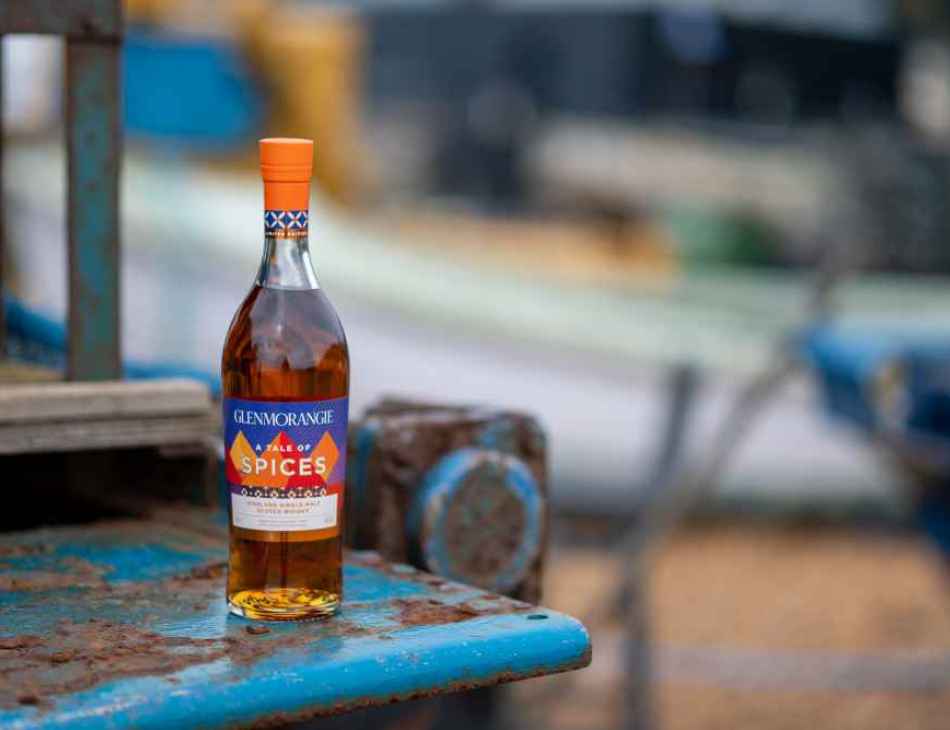Three New Whisky Releases To Buy
Glenmorangie
White Peak Distillery’s Necessary Evil Returns
Turn off the A6 and into the Derwent Valley and you’re in another world. The old Johnson & Nephew wire works loom over the river, relics of a time when men clocked in for twelve-hour shifts and left coated in soot and metal dust. Today part of that site is White Peak Distillery, founded in 2016 by Max and Claire Vaughan. What could easily have been left to crumble has instead become Derbyshire’s first whisky distillery, with a still house that feels as much cathedral as factory.
Max is from the region, and his choice of location wasn’t about image or convenience. The wire works came with water rights from the River Derwent and a sturdy set of buildings that could take on a second life. Step inside today and you’ll see the same ethos everywhere: pendant lights made from bourbon barrels, a counter fashioned from an old door, and a barrel where you can handfill your own bottles (I did two on my last visit!). The tasting room is as polished as any modern bar, but walk a little further and you’re face-to-face with copper stills, a milling room and the dunnage warehouse where the air is thick with maturing spirit.
That mix of history and forward thinking is part of what makes White Peak stand out among England’s growing number of whisky makers. The other is its closeness with Thornbridge Brewery. Every week the distillery collects spent brewer’s yeast from the brewery and uses it to start fermentation. It’s a simple arrangement that ties the two businesses together in a very literal way. Out of that link came Necessary Evil Finish, a whisky matured in casks that once held Thornbridge’s imperial stout of the same name.
This year marks the third release of Necessary Evil Finish. As before, the whisky starts its life in ex-bourbon barrels before moving into stout casks, but this time those casks have a layered past: originally red wine casks that were shaved, toasted and re-charred, then used for stout, and now pressed into service for whisky again. Bottled at 51.3% and priced at £69, it shows how playful this young distillery is.
The stout influence is unmistakable from the moment you nose this whisky. You get rich milk chocolate, roasted coffee, and hazelnuts up front, landing somewhere between melted vanilla fudge and dark syrup. There’s also a shadowy smoke and something malty that reminds you of toasted grains or bourbon biscuits, almost like coffee grounds dipped in chocolate. As it opens with a drop or two of water, deeper fruit emerges, stewed dates, orange peel, maybe even a whisper of cranberry or cherry.
When you take it on the palate, the stout character leads, but it’s joined quickly with layers of cacao nibs, dark chocolate, and roasted malt. There’s caramelised sugar, possibly even salted caramel, counterbalanced by warming spices (think nutmeg, a touch of ginger), and oak toast holding it all together. Behind all the richness you can sense the peat creeping in, not aggressive, but enough to give texture and a seasoning of smoke.
The finish is long, with dark chocolate, tobacco and roasted malt.
The whisky rested for eight months in the finishing casks, with deliberate headspace left to encourage subtle oxidation. It’s a small decision that has clearly paid off, giving the whisky time to knit together without dulling its character.
English whisky is still young compared to Scotland, but White Peak has already shown it doesn’t need to follow anyone else’s lead. Releases like this demonstrate that innovation and provenance can go hand in hand, and that a small distillery in Derbyshire can make whisky with a sense of place as strong as any. If the early years are this good, the older stock waiting in their warehouses promises something special. This truly is one of the most exciting distilleries not only in England, but the whole of the UK.
Glenmorangie’s Tale of Spices Brings the Bazaar to the Highlands
Walk through a spice market and you’ll be hit by waves of aroma before you’ve even had a chance to take in the colours. Cardamom pods jostle with saffron, ginger root stacks high alongside cinnamon sticks, and the air is thick with a warmth that is part perfume, part promise of flavour. It’s this sensation that Glenmorangie has tried to capture with its latest limited edition, A Tale of Spices.
This is the sixth release in the distillery’s imaginative A Tale Of… series, a collection that has seen whisky inspired by cake, winter, forests and even an ice-cream parlour. Each expression carries a story rooted in memory or place, and this new bottling leans into Director of Whisky Creation Dr Bill Lumsden’s long fascination with spice markets.
What makes A Tale of Spices stand out is the cask recipe. For the first time at Glenmorangie, whisky matured in bourbon barrels has been finished in four different types of cask. Moroccan red wine casks, crafted from French oak, provide an unusual influence, bringing both structure and spice. Shaved, toasted red wine casks layer in fruitier tones. Pedro Ximénez sherry wood adds its trademark sweetness, while new charred oak amplifies the spice character further. The combination could have been chaotic, but handled carefully it builds into something with depth and harmony.
The whisky makes an immediate impression on the nose, opening with fragrant rose, jasmine and a touch of lilac before rolling into warmer tones of nutmeg, ginger and cumin. Beneath the spice, there is a softer side: hints of sugared almonds, baked apple and sweet oak.. On the palate, the first burst is assertive, black pepper, mustard seed and ginger root bring an earthy heat, but this is quickly tempered by waves of demerara sugar, toffee and roasted nuts. The oak influence stays gentle, adding structure without dominating. The finish carries on with clove and cinnamon warmth, a touch of leather and lingering peppermint, leaving a balance of sweet, savoury and spice.
The packaging mirrors that idea, with warm, mosaic-like artwork designed to echo the conical mounds of spice powders you find piled high in the souks. It’s a detail that will make the whisky as giftable as it is collectable. Bottled at 46% and priced at £76, A Tale of Spices is available online through Glenmorangie, at the distillery visitor centre in Tain, and across selected specialist retailers. It has already picked up Gold at the 2025 International Spirits Competition, a sign that the judges were impressed by the balance achieved from such a complex recipe.
The distillery suggests enjoying this whisky in cocktails, particularly an Old Fashioned. I sampled it myself (they sent a pre-made bottle) and found it leaned a little too sweet for my palate, but my 28-year-old son took a different view. He was impressed by its balance, picking out layers of flavour and complexity that worked beautifully for him.
What is striking about the A Tale Of… series is how it showcases Glenmorangie’s willingness to play, and yet still retain the elegance of its house style. The tall stills at Tain produce a delicate spirit that can take on flavour without losing its finesse, and that character is still very much present here.
Glen Scotia’s 12 Year Old: A Bold New Classic for Campbeltown
Campbeltown may be Scotland’s smallest whisky-producing region today, but it still carries an outsized reputation. Once home to more than 30 distilleries, the town was known in the 19th century as the “Victorian whisky capital of the world.” Only three producers remain, and Glen Scotia is the quiet powerhouse among them, balancing tradition with a steady flow of acclaimed releases.
Now the distillery has unveiled a new flagship: the Glen Scotia 12 Year Old, a single malt designed to showcase the house style in its purest form. Fully matured in first-fill bourbon casks, bottled at 46% ABV, natural colour and non-chill filtered, it is positioned at the centre of the core range alongside the 10, 15, 18 and 25-year-old expressions.
The whisky opens with the distillery’s hallmark maritime freshness. The nose carries a rush of sea air alongside honeyed vanilla, soft orchard fruit and brighter tropical tones. On the palate, juicy pineapple and stone fruits sit against layers of vanilla fudge and caramel, before a lift of citrus sharpens the sweetness. Toasted oak and a touch of salinity underpin it all, while warming notes of nutmeg, ginger and pepper build towards the finish. The aftertaste is long, gently spiced with cinnamon and clove, leaving a balance of coastal freshness, ripe fruit and subtle oak that makes the whisky both bold and approachable.
Presentation reinforces the message. The packaging arrives in striking royal blue and chalk white, a deliberate reference to the distillery’s dunnage warehouse door and exterior wall. It is a nod to place, tying the whisky to its Campbeltown roots while introducing a refreshed brand identity that will roll out across Glen Scotia’s portfolio.
Iain McAlister, Master Distiller and Distillery Manager, calls the 12 Year Old “a bold new classic” – and it feels like exactly that. It offers a clear statement of the distillery’s character: tropical fruit layered with maritime influence, delivered with the confidence of a whisky that knows where it comes from.
At £45, available exclusively through glenscotia.com, the distillery’s visitor centre, and The Whisky Shop, the Glen Scotia 12 Year Old is intended to be accessible, both in price and in flavour profile. It gives newcomers a direct route into the Campbeltown style, while offering long-time fans another dimension of Glen Scotia’s character.











